The Parable of the Fig Tree, found in Luke 13:6-9, highlights the necessity of spiritual fruitfulness and the call for repentance. In this story, God, represented by the vineyard owner, expresses disappointment over a barren fig tree, symbolizing Israel's unfaithfulness. The gardener, symbolizing Jesus, advocates for giving the tree more time to bear fruit, reflecting God's grace and patience. This parable reminds you of the urgent need for spiritual maturity and the importance of cultivating your relationship with God. As you explore further, you'll uncover even deeper meanings and implications behind this powerful message.
Key Takeaways
- The Parable of the Fig Tree illustrates God's expectations for spiritual fruitfulness among His people, symbolized by the fig tree's barrenness.
- In the parable, the vineyard owner represents God, expressing disappointment, while the gardener symbolizes Jesus, advocating for patience and care.
- The fig tree serves as a prophetic symbol for Israel's spiritual state, reflecting the need for repentance and readiness for divine judgment.
- Spiritual growth parallels the fig tree's cultivation, requiring consistent effort, community support, and nurturing practices like prayer and study.
- The parable emphasizes God's grace, highlighting the urgency for repentance while offering hope for renewal and the fulfillment of divine promises.
Introduction

As you delve into the Parable of the Fig Tree, you'll discover a powerful narrative that captures God's expectations for fruitfulness in our lives. This parable, found in Luke 13:6-9, illustrates the importance of producing spiritual fruit and the urgent call for repentance.
The vineyard owner, representing God, expresses disappointment after three years of finding no fruit on the fig tree. This symbolizes God's displeasure with unfruitfulness not just in Israel but also in individual believers.
You'll notice the gardener, who represents Jesus, intercedes for the fig tree, asking for one more year of care and cultivation. This act demonstrates Jesus' advocacy for humanity and highlights God's mercy, reminding you that while He's patient, there's a limited time to respond to His call.
The Parable of the Fig serves as a poignant reminder that spiritual growth isn't optional; it's essential. If you reflect on your own life, consider whether you're living up to God's expectations and producing the fruit He desires.
The narrative encourages you to evaluate your relationship with God and to be open to His call for repentance before the time runs out.
Fig Tree Symbolism in Scripture
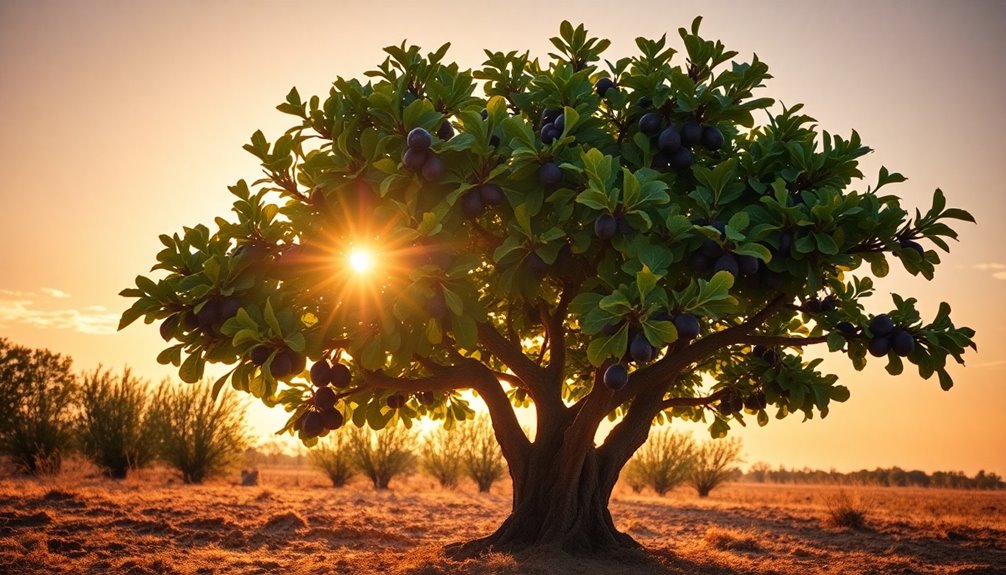
When you explore the symbolism of the fig tree in Scripture, you'll find it rich with meaning related to Israel's spiritual state.
Primary references, like the parable in Luke 13, highlight divine favor and judgment, while secondary references further illustrate its significance in righteousness and prophetic contexts.
Understanding these connections can deepen your insight into biblical teachings.
Primary Bible References
The fig tree stands as a powerful symbol in scripture, reflecting Israel's spiritual journey and God's relationship with His people. In Luke 13:6-9, the fig tree represents divine favor when it's fruitful, contrasting sharply with God's judgment when it's barren. This scripture underscores the importance of spiritual productivity in your life.
Jesus further illustrates this concept in Matthew 24:32-35, using the fig tree as a metaphor for recognizing the signs of prophetic fulfillment. It's a call for you to be vigilant and aware of spiritual developments around you.
In Habakkuk 3:17, the fig tree signifies despair and barrenness, mirroring Israel's unfaithfulness during tough times. The withering of the fig tree in Matthew 21:18-22 serves as a stark warning against unfruitfulness, urging you toward repentance and faithfulness.
Additionally, fig trees symbolize abundance and blessings in Deuteronomy 8:8, showcasing the prosperity you can expect from a faithful relationship with God. These primary references reveal the multifaceted role of the fig tree in conveying God's messages and expectations for His people.
Secondary Bible References
Fig tree symbolism in scripture highlights the spiritual state of Israel and serves as a reminder for you to assess your own faithfulness. In various biblical contexts, fig trees represent Israel's spiritual condition. When fig trees are fruitful, they symbolize righteousness and divine favor, as seen in Hosea 9:10. In contrast, barren fig trees signify judgment and rejection, urging you to reflect on your own spiritual fruitfulness.
Jesus uses the fig tree metaphor in Matthew 24:32-35 to illustrate the signs of the times, calling you to remain vigilant and ready for His return. Similarly, Habakkuk 3:17 depicts the absence of fig trees as a sign of desolation, paralleling Israel's unfruitfulness and the need for repentance.
Psalm 1:3 further emphasizes this theme by comparing the righteous to flourishing trees, highlighting the connection between spiritual vitality and divine blessing.
The withering of the fig tree in Mark 11:12-14 serves as a prophetic warning about impending judgment on unfruitful Israel, marking a transition from the old covenant to a new one that encompasses all nations. These references compel you to evaluate your spiritual life and commitment.
First-Century Agricultural Practices
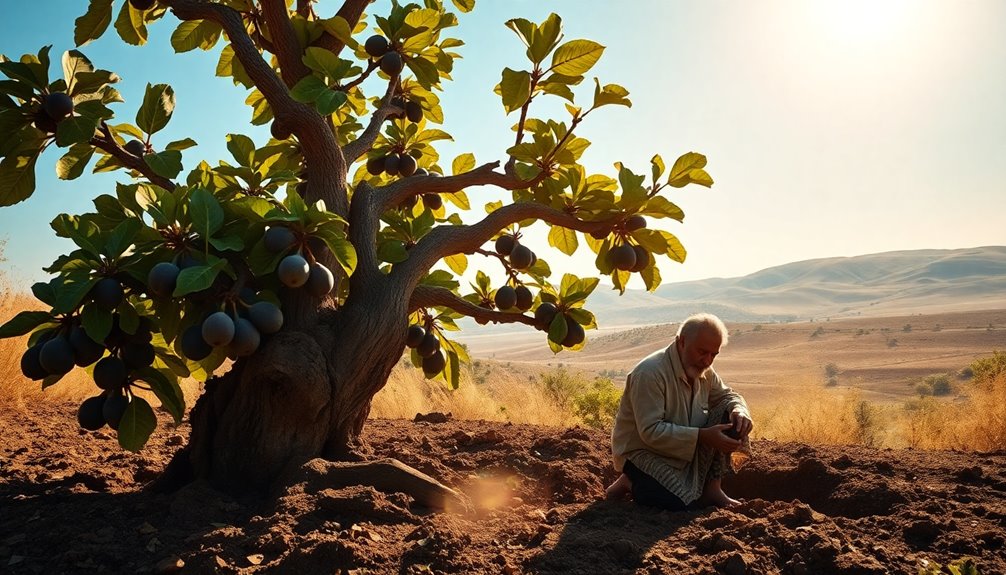
Cultivating fig trees in the first century involved meticulous practices that ensured a bountiful harvest. You'd start by selecting well-drained soil, giving your fig trees the best chance to thrive.
Spacing was crucial; by allowing enough room for sunlight and airflow, you encouraged optimal growth. Without chemical fertilizers, farmers like you relied on organic options, such as animal manure, to enrich the soil and promote the overall health of the fig tree.
Pruning was another vital task. By trimming back dead or diseased branches, you not only improved the tree's appearance but also stimulated the growth of new, fruit-bearing shoots. This practice greatly contributed to your yield.
When it came to harvesting, timing was everything. You'd need to wait until late summer or early autumn for the figs to ripen perfectly. Manual picking was essential, as the delicate fruit could easily be damaged if not handled carefully.
Fig Tree as Prophecy Symbol
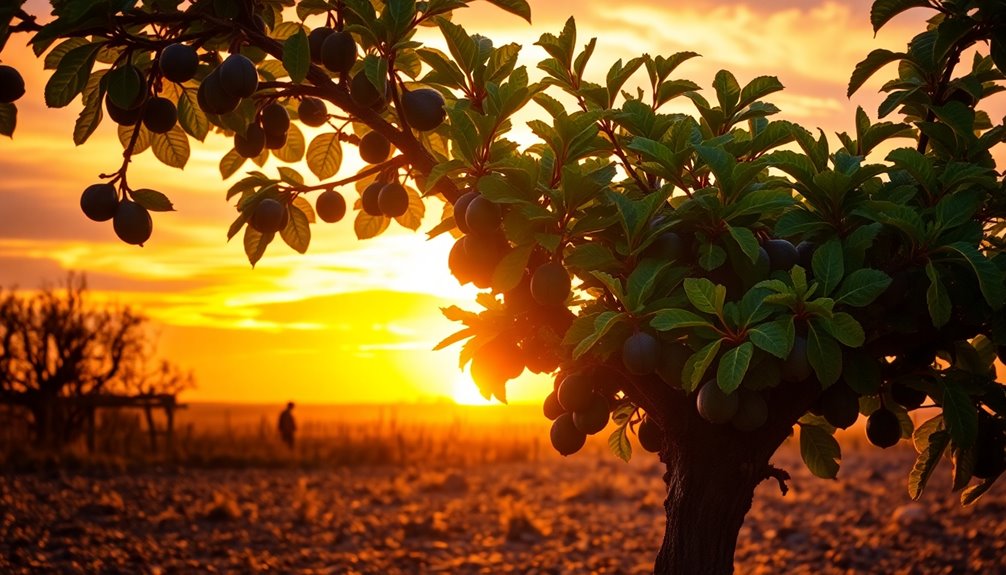
Throughout biblical texts, the fig tree serves as a powerful symbol of Israel's spiritual condition, reflecting themes of divine favor and impending judgment. When fruitful, the fig tree signifies God's blessing and Israel's faithfulness. Conversely, its barrenness represents unfaithfulness and idolatry, revealing God's disappointment and calling for repentance.
In Matthew 24:32-35, Jesus uses the fig tree as a metaphor, urging you to recognize the signs of the times and emphasizing the importance of spiritual readiness.
The withering of the fig tree acts as a prophetic warning about the consequences of spiritual barrenness. This imagery highlights a significant transition from the old covenant with Israel to the new covenant in Christ.
As ripe figs symbolize the return of Christ, the fig tree encompasses not just Israel but broader humanity, inviting everyone to be prepared for His second coming.
Understanding the fig tree in this prophetic context fosters a deeper awareness of your spiritual state. It challenges you to reflect on your relationship with God and encourages a commitment to faithfulness, ensuring you bear fruit that aligns with His divine will.
Fig Tree's Seasonal Significance
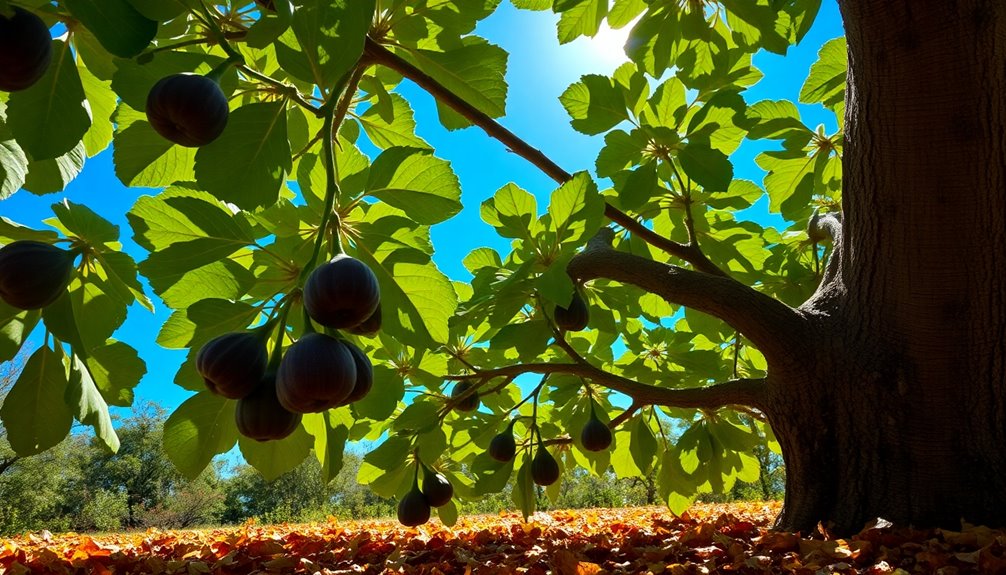
When you think about the fig tree, it's easy to get caught up in misconceptions about its fruitfulness.
You might wonder why some argue over its ability to bear fruit in certain seasons, especially given its natural growth cycle.
Understanding this seasonal significance can help clarify the deeper spiritual messages behind the parable.
Debunk Common Misunderstandings
Many people misunderstand the fig tree's seasonal significance, assuming that its fruitfulness should align with a strict calendar year. In reality, the fig tree bears fruit in late summer to early autumn, meaning the three-year wait in the parable reflects the tree's growing cycle, not just a literal timeframe.
Unlike many fruit trees, a fig tree can produce two crops in a single year: the "breba" on last year's wood and the second crop on this year's growth. This dual potential highlights the tree's capacity for fruitfulness.
The disappointment expressed by the owner after three years may seem unrealistic, but it emphasizes God's urgency for spiritual fruitfulness from His people. Seasonal variations, like drought or poor soil, can impact a fig tree's productivity, paralleling the spiritual conditions in individuals or nations.
Understanding the fig tree's growth cycle clarifies that the gardener's request for more time symbolizes God's grace and patience, allowing for spiritual renewal and repentance.
Fig Tree's Fruitfulness Debate
The debate surrounding the fig tree's fruitfulness highlights the essential nature of timing and readiness in both agriculture and spiritual life. The fig tree typically bears fruit twice a year, making it crucial to understand the vineyard owner's expectations.
In the parable, the three-year wait for fruit reflects not only the fig tree's growth cycle but also symbolizes God's patience during the ministries of John the Baptist and Jesus.
The gardener's request for an additional year emphasizes the importance of seasonal care and the opportunity for spiritual renewal before judgment occurs. Just as fig trees need proper pruning and fertilization to be productive, the gardener's efforts represent the nurturing required for spiritual growth.
This debate also underscores the urgency of spiritual readiness—failure to produce fruit during designated seasons could lead to destruction. It mirrors the consequences of unrepentance in spiritual life, reminding you that growth takes time but requires your active participation.
Fig Tree's Growth Cycles
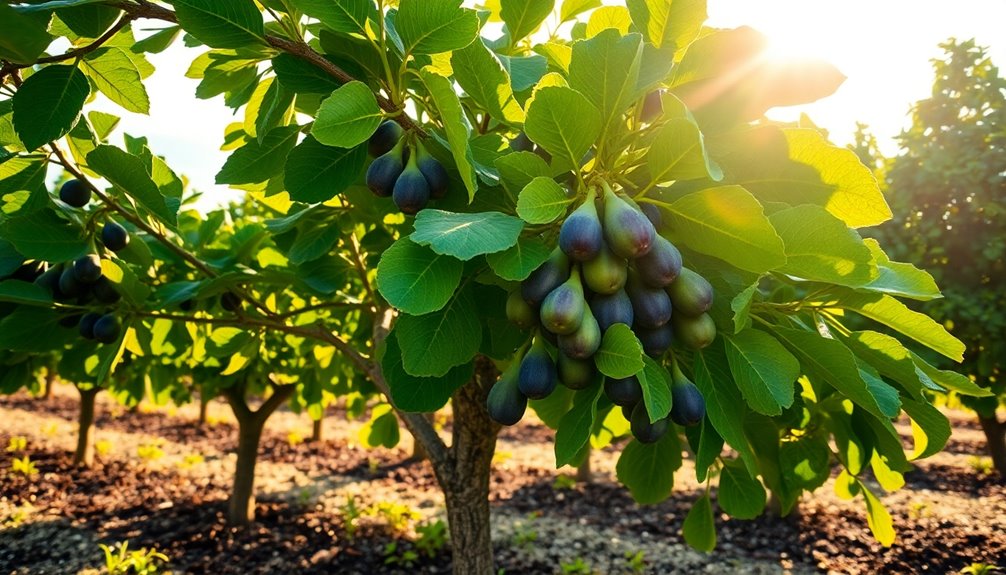
As you reflect on your own growth, consider how the fig tree's cycles mirror your journey.
Just like a fig tree needs time and care to mature, communities also thrive when nurtured through thoughtful strategies.
Personal Reflection on Growth
Nurturing your personal growth often mirrors the life cycle of a fig tree, which takes time to mature and bear fruit. Just like a fig tree requires around three years to begin producing, your journey towards spiritual maturity demands patience and consistent effort.
You need to cultivate your spiritual life through practices like prayer, study, and repentance—these are essential for producing your own spiritual fruit.
Seasonal changes in the fig tree's life symbolize the importance of timing and divine patience in your growth. There may be periods when you feel spiritually barren, but these times can lead to profound transformation if you nurture them with grace.
The cycle of dormancy and renewal reflects your own challenges and triumphs, reminding you that growth isn't always linear.
Understanding the fig tree's growth cycles offers a powerful metaphor for your personal development. It's a reminder that growth takes time, and just like the gardener tending to the tree, you must invest intentional effort and seek divine support.
Embrace the journey, knowing that with patience and care, you too can bear fruit in due season.
Community Growth Strategies
Understanding your personal growth can lead to insights about nurturing community development. Just like a fig tree, your community needs the right conditions to flourish. It requires well-drained soil, which represents a solid foundation of values and support.
Ensure your community gets adequate sunlight—exposure to new ideas and diverse perspectives is crucial for growth. Regular engagement acts as watering; without it, your community may struggle to thrive.
Pruning is essential for a fig tree's fruitfulness, just as addressing areas needing improvement fosters spiritual maturation. Identify aspects that may be hindering growth and encourage constructive change.
Remember, a fig tree can produce fruit multiple times a year under optimal conditions. Your community, too, has the potential for ongoing growth—consistency in support and engagement is key.
Finally, be patient and aware of seasonal cycles. Just as it takes time for a fig tree to bear fruit, community growth demands sustained commitment. Celebrate small successes along the way, and keep nurturing the environment, knowing that fruitful results will come in due time. Additionally, implementing stress management techniques within your community can enhance overall well-being and resilience among members.
Fig Tree's Prophetic Implications

The fig tree serves as a powerful symbol in biblical texts, particularly reflecting Israel's spiritual state and its readiness for divine judgment or favor. In Jesus' teachings, the barrenness of the fig tree highlights Israel's unfruitfulness and the urgent need for repentance.
When you consider the withering of the fig tree in Matthew 21:18-22, it becomes clear this act serves as a prophetic sign of the consequences of spiritual barrenness. It emphasizes the transition from the old covenant to the new and calls for a renewed commitment to faithfulness.
You might also see the fig tree's blossoming as a sign of hope, linking it to eschatological themes. This blossoming represents not just spiritual renewal but also the fulfillment of God's promises to Israel and humanity.
Thus, the fig tree's ability to bear fruit becomes a metaphor for the readiness to embrace God's grace and respond to His call. By grasping the prophetic implications of the fig tree, you can better understand the urgency behind Jesus' message: it's time to bear fruit, cultivate faith, and prepare for the coming of the Kingdom.
Additional Resources
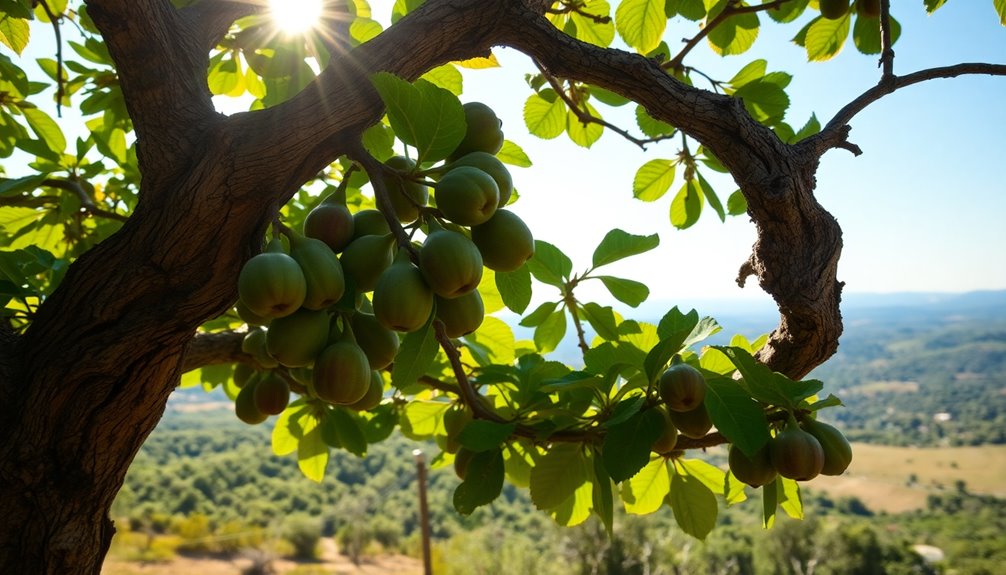
Exploring additional resources can deepen your grasp of the parable of the fig tree and its implications. One insightful read is "The Barren Fig-Tree" by Roger Baxter, which offers reflective insights into spiritual fruitfulness and encourages you to examine your own life.
Timothy Maurice Pianzin's work places the parable within its historical context, helping you appreciate the cultural significance of the fig tree and its role in Jesus' teachings.
For a theological perspective, Cornelius a Lapide's commentary interprets the fig tree as a symbol of the Jewish synagogue, emphasizing the urgent need for repentance. Peter Rhea Jones also highlights the call for spiritual growth, examining how the parable serves as a reminder of accountability in your faith journey.
Additionally, biblical references like Isaiah 5:1-7 and Matthew 21:18-22 provide context for the themes of judgment and mercy. By engaging with these resources, you can explore the deeper meanings behind the barren fig tree and reflect on its lessons in your own life.
Each resource helps illuminate the essential truths woven into this powerful parable.
Frequently Asked Questions
What Is the Meaning of the Parable of the Fig Tree?
The meaning of the parable of the fig tree revolves around the idea of spiritual growth and accountability.
It emphasizes that you're expected to bear fruit in your life—demonstrating faith through actions and repentance.
The urgency of this message highlights that, while there's grace and the opportunity for change, unfruitfulness can lead to consequences.
Ultimately, it's a call for you to reflect on your spiritual journey and strive for genuine transformation.
What Does the Parable of the Fig Tree Mean in Matthew 24 32 35?
In Matthew 24:32-35, you see that Jesus uses the fig tree to illustrate how certain signs indicate the approach of significant events.
Just as the leaves signal summer, you're reminded to be alert to spiritual signs around you. Jesus emphasizes that His words are enduring and reliable, urging you to remain vigilant and ready for His return.
This passage calls you to discern the times and live faithfully in anticipation of God's promises.
What Does the Fig Tree Symbolize in the Bible?
In the Bible, the fig tree symbolizes various aspects of spiritual health and readiness.
It represents Israel's relationship with God, where fruitfulness indicates divine favor, while barrenness reflects judgment.
You'll see it as a metaphor for humanity's potential for spiritual growth, emphasizing the importance of being spiritually alert.
Ripe figs signify readiness for Christ's return, reminding you of God's promises and the necessity of living a fruitful, faithful life.
What Is the Significance of the Fig Tree in Luke 21?
In Luke 21, the fig tree's significance lies in its ability to signal change.
Just as you notice the tree budding to anticipate summer, you're called to recognize the signs of the times around you.
Jesus emphasizes that these events indicate the nearing of God's Kingdom.










